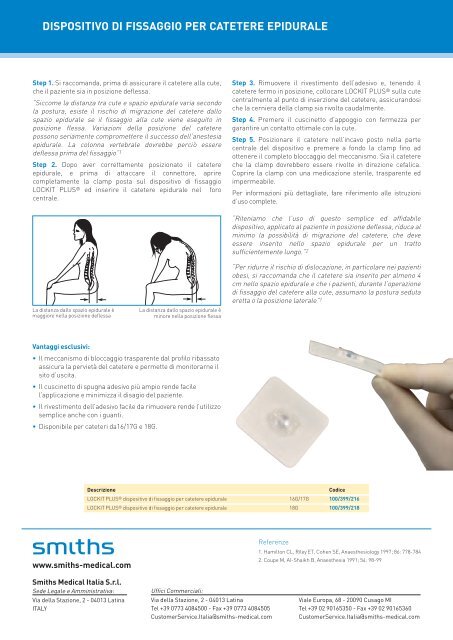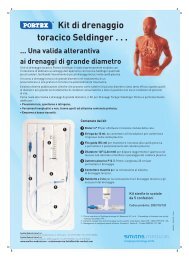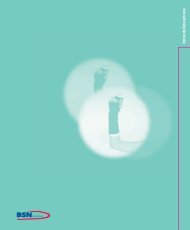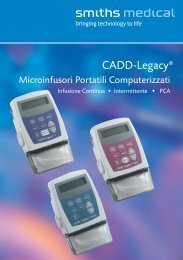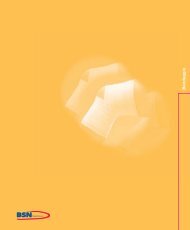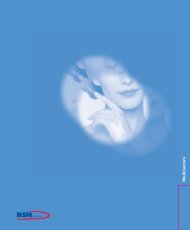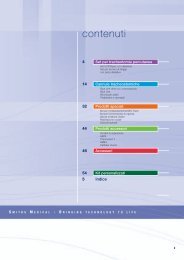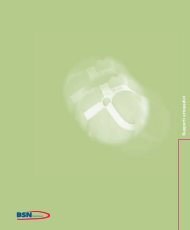dispositivo di fissaggio per catetere epidurale - Farmasan
dispositivo di fissaggio per catetere epidurale - Farmasan
dispositivo di fissaggio per catetere epidurale - Farmasan
You also want an ePaper? Increase the reach of your titles
YUMPU automatically turns print PDFs into web optimized ePapers that Google loves.
DISPOSITIVO DI FISSAGGIO PER CATETERE EPIDURALE<br />
Step 1. Si raccomanda, prima <strong>di</strong> assicurare il <strong>catetere</strong> alla cute,<br />
che il paziente sia in posizione deflessa.<br />
“Siccome la <strong>di</strong>stanza tra cute e spazio <strong>epidurale</strong> varia secondo<br />
la postura, esiste il rischio <strong>di</strong> migrazione del <strong>catetere</strong> dallo<br />
spazio <strong>epidurale</strong> se il <strong>fissaggio</strong> alla cute viene eseguito in<br />
posizione flessa. Variazioni della posizione del <strong>catetere</strong><br />
possono seriamente compromettere il successo dell’anestesia<br />
<strong>epidurale</strong>. La colonna vertebrale dovrebbe <strong>per</strong>ciò essere<br />
deflessa prima del <strong>fissaggio</strong>” 1<br />
Step 2. Dopo aver correttamente posizionato il <strong>catetere</strong><br />
<strong>epidurale</strong>, e prima <strong>di</strong> attaccare il connettore, aprire<br />
completamente la clamp posta sul <strong><strong>di</strong>spositivo</strong> <strong>di</strong> <strong>fissaggio</strong><br />
LOCKIT PLUS ® ed inserire il <strong>catetere</strong> <strong>epidurale</strong> nel foro<br />
centrale.<br />
Step 3. Rimuovere il rivestimento dell’adesivo e, tenendo il<br />
<strong>catetere</strong> fermo in posizione, collocare LOCKIT PLUS ® sulla cute<br />
centralmente al punto <strong>di</strong> inserzione del <strong>catetere</strong>, assicurandosi<br />
che la cerniera della clamp sia rivolta caudalmente.<br />
Step 4. Premere il cuscinetto d’appoggio con fermezza <strong>per</strong><br />
garantire un contatto ottimale con la cute.<br />
Step 5. Posizionare il <strong>catetere</strong> nell’incavo posto nella parte<br />
centrale del <strong><strong>di</strong>spositivo</strong> e premere a fondo la clamp fino ad<br />
ottenere il completo bloccaggio del meccanismo. Sia il <strong>catetere</strong><br />
che la clamp dovrebbero essere rivolte in <strong>di</strong>rezione cefalica.<br />
Coprire la clamp con una me<strong>di</strong>cazione sterile, trasparente ed<br />
im<strong>per</strong>meabile.<br />
Per informazioni più dettagliate, fare riferimento alle istruzioni<br />
d’uso complete.<br />
La <strong>di</strong>stanza dallo spazio <strong>epidurale</strong> è<br />
maggiore nella posizione deflessa<br />
La <strong>di</strong>stanza dallo spazio <strong>epidurale</strong> è<br />
minore nella posizione flessa<br />
“Riteniamo che l’uso <strong>di</strong> questo semplice ed affidabile<br />
<strong><strong>di</strong>spositivo</strong>, applicato al paziente in posizione deflessa, riduca al<br />
minimo la possibilità <strong>di</strong> migrazione del <strong>catetere</strong>, che deve<br />
essere inserito nello spazio <strong>epidurale</strong> <strong>per</strong> un tratto<br />
sufficientemente lungo.” 2<br />
“Per ridurre il rischio <strong>di</strong> <strong>di</strong>slocazione, in particolare nei pazienti<br />
obesi, si raccomanda che il <strong>catetere</strong> sia inserito <strong>per</strong> almeno 4<br />
cm nello spazio <strong>epidurale</strong> e che i pazienti, durante l’o<strong>per</strong>azione<br />
<strong>di</strong> <strong>fissaggio</strong> del <strong>catetere</strong> alla cute, assumano la postura seduta<br />
eretta o la posizione laterale” 1<br />
Vantaggi esclusivi:<br />
• Il meccanismo <strong>di</strong> bloccaggio trasparente dal profilo ribassato<br />
assicura la <strong>per</strong>vietà del <strong>catetere</strong> e <strong>per</strong>mette <strong>di</strong> monitorarne il<br />
sito d’uscita.<br />
• Il cuscinetto <strong>di</strong> spugna adesivo più ampio rende facile<br />
l’applicazione e minimizza il <strong>di</strong>sagio del paziente.<br />
• Il rivestimento dell’adesivo facile da rimuovere rende l’utilizzo<br />
semplice anche con i guanti.<br />
• Disponibile <strong>per</strong> cateteri da16/17G e 18G.<br />
Descrizione<br />
Co<strong>di</strong>ce<br />
LOCKIT PLUS ® <strong><strong>di</strong>spositivo</strong> <strong>di</strong> <strong>fissaggio</strong> <strong>per</strong> <strong>catetere</strong> <strong>epidurale</strong> 16G/17G 100/399/216<br />
LOCKIT PLUS ® <strong><strong>di</strong>spositivo</strong> <strong>di</strong> <strong>fissaggio</strong> <strong>per</strong> <strong>catetere</strong> <strong>epidurale</strong> 18G 100/399/218<br />
www.smiths-me<strong>di</strong>cal.com<br />
Referenze<br />
1. Hamilton CL, Riley ET, Cohen SE, Anaesthesiology 1997; 86: 778-784<br />
2. Coupe M, Al-Shaikh B, Anaesthesia 1991; 54: 98-99<br />
Smiths Me<strong>di</strong>cal Italia S.r.l.<br />
Sede Legale e Amministrativa:<br />
Via della Stazione, 2 - 04013 Latina<br />
ITALY<br />
Uffici Commerciali:<br />
Via della Stazione, 2 - 04013 Latina<br />
Tel +39 0773 4084500 - Fax +39 0773 4084505<br />
CustomerService.Italia@smiths-me<strong>di</strong>cal.com<br />
Viale Europa, 68 - 20090 Cusago MI<br />
Tel +39 02 90165350 - Fax +39 02 90165360<br />
CustomerService.Italia@smiths-me<strong>di</strong>cal.com
LOCKIT PLUS ®<br />
La nuova generazione <strong>di</strong> <strong>di</strong>spositivi<br />
<strong>di</strong> <strong>fissaggio</strong> <strong>per</strong> cateteri epidurali<br />
NUOVO DESIGN<br />
Profilo più sottile<br />
Maggior stabilità<br />
PAINMANAGEMENT


